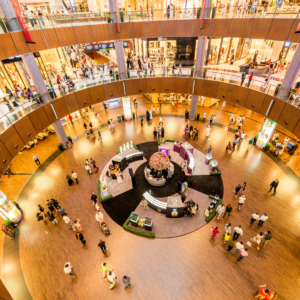Similarly, but not synonymously, the hospitality sector consists of many business types whose sales contribute to the hospitality market. The hospitality industry includes but is not limited to restaurants, hotels (and all variations thereupon), entertainment, and event planning. This means that anytime you are staying in a hotel, eating at or from a restaurant, or watching a movie, you are contributing to the hospitality sector.
When a new H-E-B opens with a True Texas BBQ inside, that can represent an intersection of the retail and hospitality markets. Buying new clothes for a night out can represent an intersection of the retail and hospitality markets. The extent to which these two sectors crossover and intertwine cannot be overstated.
How do the Retail and Hospitality Sectors Align and Differ?
 Put simply, in most cases, the retail sector varies from the hospitality sector because retail is the selling of goods to consumers whereas hospitality is the selling of services to consumers. While there have been transitions in recent years to accommodate the rise of e-commerce, and is subject to economic trends, the retail sector is incredibly resilient as it is so vast, encompassing so many industries. The same cannot be said for the hospitality sector because it relies so heavily on travel, tourism, and recreation patterns. A prime example of this weakness is the impact the COVID-19 pandemic had on the hospitality market. The transition from tourism, traveling, and indulging in entertainment outside the house to staying home during the pandemic hit the hospitality sector harder than almost any other industry.
Put simply, in most cases, the retail sector varies from the hospitality sector because retail is the selling of goods to consumers whereas hospitality is the selling of services to consumers. While there have been transitions in recent years to accommodate the rise of e-commerce, and is subject to economic trends, the retail sector is incredibly resilient as it is so vast, encompassing so many industries. The same cannot be said for the hospitality sector because it relies so heavily on travel, tourism, and recreation patterns. A prime example of this weakness is the impact the COVID-19 pandemic had on the hospitality market. The transition from tourism, traveling, and indulging in entertainment outside the house to staying home during the pandemic hit the hospitality sector harder than almost any other industry.
Both sectors are heavily influenced by trends and societal behaviors. For example, in the hospitality industry, the popularity of theme parks may fluctuate. Additionally, trends in things like sustainable tourism, sustainable construction, and sustainable consumptions can determine what and when people consume. Other factors influencing both sectors include economic trends, technological advancements, and supply chain issues. The retail and hospitality sectors are a vital part of the United States economy, employing millions of people nationwide and millions more worldwide. People all across the globe rely on the retail and hospitality sectors for employment and purchasing necessary goods and services. This means that the performance and outlook of these sectors influences billions of lives, including your own.
Location and franchise also greatly impact the outlook of the retail and hospitality sectors on a microeconomic level. For example, the retail sector in Jacksonville, Florida may be experiencing extremely different outcomes than that of Houston, Texas. Along those same lines, the outlook for the hospitality market of MacDonald’s specifically may vary widely from that of Burger King.
How has the Retail and Hospitality Market been Performing in 2023?
Thus far in 2023, the hospitality market has been performing remarkably despite the looming threat of an economic recession. Although the industry is still recovering from the impacts of the COVID-19 pandemic, the industry grew by over $300 million USD from 2022 to 2023. This can be contributed, at least in part, to the global movement back toward pre-pandemic norms. In other words, people are leaving their houses more. People are returning to restaurants, traveling, and staying in hotels more often than in the last three years.
The retail market grew by nearly $2 billion USD from 2022 to 2023. While the majority of retail sales are still occurring in person at physical stores, since the start of the pandemic there has been a shift towards e-commerce, giving online shopping a more prominent role in the retail sector than ever before. We are still seeing remnants of major 2022 issues such as the labor shortage and supply chain issues, but they appear to be much less prevalent than in previous years.
2024 Retail Sector Outlook
 The retail market is expected to continue to improve on its way to returning to pre-pandemic norms. With many sources predicting that inflation will slow in late 2023 and into 2024, the retail market has potential to continue to grow. Given the vastness and complexity of the retail sector, forecasting the retail market comes with substantial barriers. Predictions can range from sizable growth to near record lows depending on the source and data used to determine the estimates. As of now, outlooks seem positive, with many sources predicting positive growth and continued perseverance despite economic instability
The retail market is expected to continue to improve on its way to returning to pre-pandemic norms. With many sources predicting that inflation will slow in late 2023 and into 2024, the retail market has potential to continue to grow. Given the vastness and complexity of the retail sector, forecasting the retail market comes with substantial barriers. Predictions can range from sizable growth to near record lows depending on the source and data used to determine the estimates. As of now, outlooks seem positive, with many sources predicting positive growth and continued perseverance despite economic instability
2024 Hospitality Sector Outlook
The United States hospitality sector has continued to prevail against formidable obstacles such as the 2023 bank failures and recession trends. Similarly, to the retail market, the gradual reversion to pre-pandemic norms has revitalized the hospitality market, seeing a rise in travel and tourism. The growth is not predicted to be as significant as in previous pre-pandemic years, but there is still expected to be positive growth closing out 2023 and into 2024. The recovery of the hospitality market following the COVID-19 pandemic and recent economic trends is expected to be slow, but it is expected to recover.
Conclusion
The retail and hospitality markets are recovering. This is evident in the many projects underway right now, including a new Mansfield, Texas development on U.S. Highway 287 that will include retail, office, and hotel (hospitality) spaces. H-E-B also recently announced the opening date of three new stores in Dallas-Fort Worth. So, despite the COVID-19 pandemic and the obstacles that may lie ahead, the retail and hospitality sectors are resilient and have already overcome various setbacks. Overall, the outlook for the retail and hospitality markets appears positive throughout the United States.






